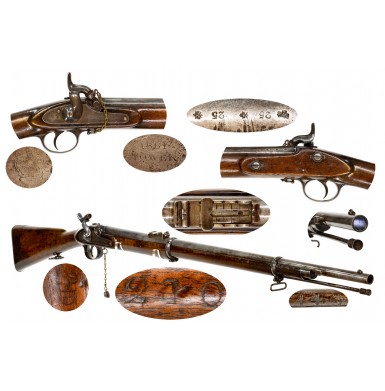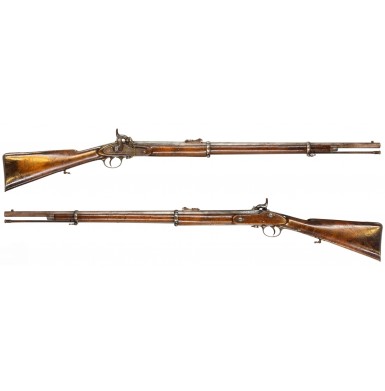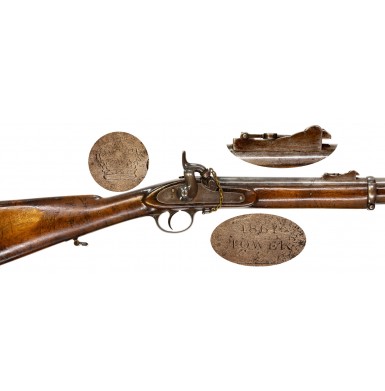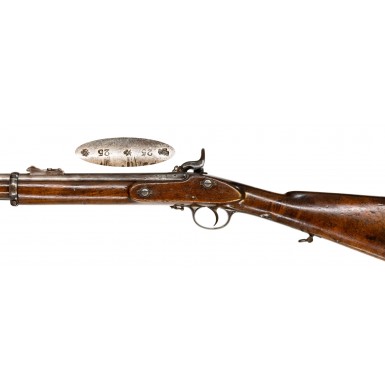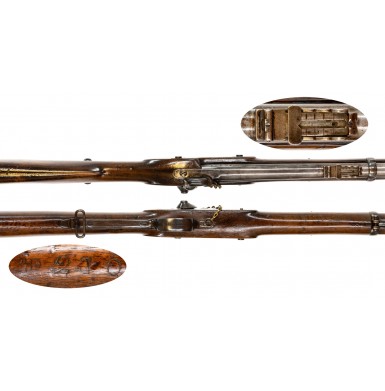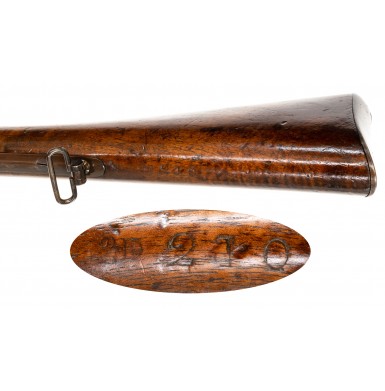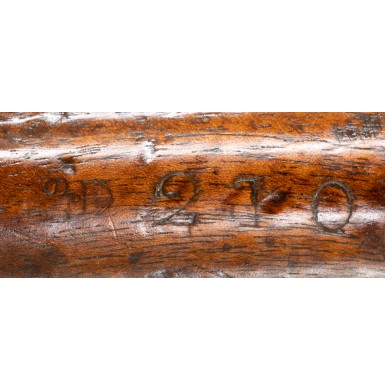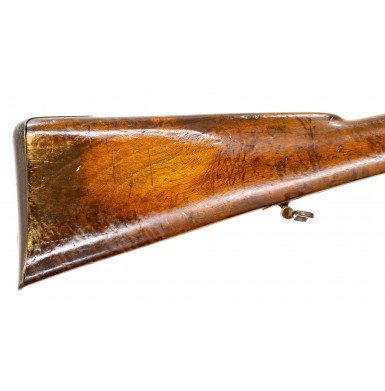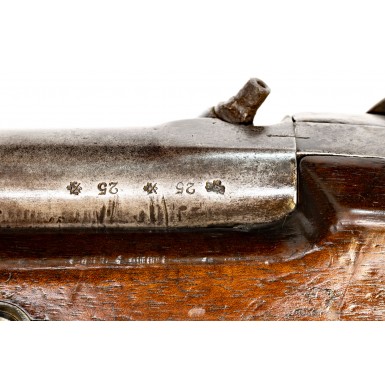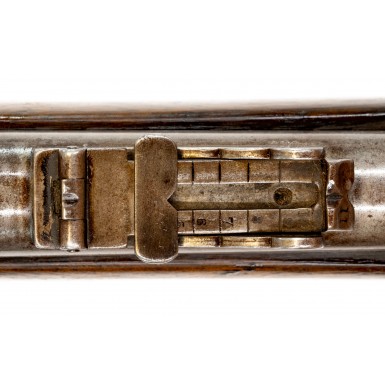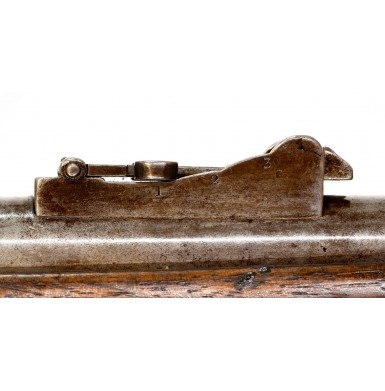Rare Confederate Imported and Inventory Numbered Pattern 1856 Enfield Rifle
- Product Code: FLA-3986J-SOLD
- Availability: Out Of Stock
-
$7,500.00
This is a VERY GOOD condition example of a rarely encountered Confederate imported English Pattern 1856 Iron Mounted Enfield “Short Rifle”. The gun bears the highly desirable Confederate J S / {ANCHOR} viewer’s mark behind the triggerguard and has the Confederate inventory number 210 stamped into the wood of the belly of the stock. The end of the original period ramrod is engraved with the Confederate inventory number 140, only seventy numbers from this gun.
Between 1861 and 1863, the Confederacy entered into a several contracts with the firm of Sinclair, Hamilton & Company in Great Britain for the delivery of English “Enfield” pattern percussion long arms of all varieties. Many of these contracts are well documented in the papers of Confederate General Colin McRae, which now reside in the collection of the South Carolina Military Museum & Relic Room, in Columbia, SC. While the purchases concentrated on Pattern 1853 Enfield rifle muskets (“long Enfields”) for use by the Confederate infantry, a number of Enfield pattern “short rifles” and carbines, both artillery and cavalry patterns, were obtained as well. Confederate documents reveal that the second Sinclair, Hamilton & Company contract included 30,000 Pattern 1853 “Long Enfields”, as well as 10,000 “short rifles” of varying patterns. The 40,000 guns from these contracts are the ones that are found with the both the J S / {ANCHOR} viewer’s mark and Confederate inventory number markings. The “Long Enfields” were serialized in three series, from 1-10,000, 1-10,000 with an “A” suffix and 1-10,000 with a “B” suffix (although no gun bearing “10,000” has ever been encountered). The short rifles were simply numbered in their own series from 1-10,000 without any letter suffixes. The short rifles were a mixture of standard Pattern 1856 and Pattern1856 Type II (also known as the Pattern 1858 or “Bar on Band”) iron mounted rifles, as well as non-standard brass mounted Pattern 1856 and Pattern 1856 Type II rifles. A handful of the brass mounted Pattern 1858 Naval Rifles, and a few iron mounted Pattern 1860 and Pattern 1861 rifles were also purchased. Many of the earliest Confederate short rifle purchases took the form of “Volunteer Rifles”, which were enhanced and embellished commercial versions of the standard military rifles. These guns were intended for sale to the local British “Volunteer” units, which were essentially the local militias that were as much shooting clubs and social organizations as they were quasi-military units. Several low-numbered “short rifles” with checkered stocks, engraved metal and other upgraded features are known with Confederate importation marks on them.
The Pattern 1856 Enfield “Short Rifle” was the standard British military rifle of the era, and had a 33” barrel, with a .577 caliber bore which was rifled with three-groove, progressive depth rifling. The rear sight was graduated to 1,100 yards, while the rifle musket sights were graduated to 900 or later 1,000 yards and was set just behind the rear barrel band; further forward on the barrel than the sights used on the rifle musket. The rifle was equipped with a saber bayonet lug on the right side of the barrel, near the muzzle, to accommodate a Yataghan blade bayonet. The earliest production rifles had a short “key” or “lead” forward of the actual lug, but this feature was quickly eliminated, and the majority of Pattern 1856 rifles have standard bayonet lugs without that short guide key. The rifle had a rear sling swivel attached to a lug, screwed into the rear of the extended iron triggerguard tang, with the upper swivel attached to the upper barrel band. As with the Pattern 1853 Enfield Rifle Muskets, the iron mounted rifles had blued barrels and color case hardened locks and hammers. The furniture (triggerguard, butt plate, stock escutcheons, nose cap etc.) of the “iron mounted” rifles was made of iron rather than brass and was color casehardened (with the exception of the nose cap) as well. Due to the difficulty of engraving numbers in the case hardened buttplate tang, the iron mounted rifles that were inventory numbered were stamp-marked with their numbers in the wood of the stock belly.
The Enfield “Short Rifles” were lighter and handier than the longer rifle muskets and were preferred for use not only by Confederate infantry that functioned as skirmishers and sharpshooters, but by Confederate cavalry that tended to operate as mounted infantry, rather than as traditional light and heavy cavalry. Confederate cavalry commanders J.E.B. Stuart and Nathan Bedford Forrest were both proponents of issuing Enfield short rifles to their cavalry troopers. Short rifles with saber bayonets are known to have been issued to Confederate infantry regiments serving in Kershaw’s South Carolina Brigade, the 10th, 16th, 18th & 51st Georgia, the 13th, 17th, 18th & 51st Mississippi, the 41st Tennessee, the 1st Battalion of Texas Sharpshooters, and the 5th Texas. Mounted Confederate units that are known to have been issued the “short Enfield rifle” were Cobb’s & Phillip’s Legions of Georgia, the 18th & 19th Mississippi cavalry (McCulloch’s Brigade of Forrest’s 2nd Cavalry), the 2nd North Carolina cavalry, the 3rd, 6th, 9th & 27th Texas cavalry (Ross’ brigade) and the 7th Virginia cavalry. Today, a multi-decade survey of extant surviving Confederate marked and inventory numbered Enfield short rifles reveals that less than 120 of these guns have survived, which represents only slightly more than 1% of the total number purchased. While some are in private collections, many others reside in museum or other public collections where they can be viewed, but never owned by a collector. This makes the numbered Confederate purchased Enfield Short Rifle a very difficult item to find for sale and available to add to a collection.
This Confederate purchased Pattern 1856 Iron Mounted Enfield Short Rifle is in about VERY GOOD condition and has a rarely found inventory numbered ramrod. Although the ramrod does not match the gun, it is 70 numbers off, the rarity of these numbered rods is such that this is a wonderful bonus. The gun has clearly seen a moderate amount of service in the field but remains amazingly complete and in wonderful condition for a Confederate used long arm that likely served for almost the entire war. The gun was manufactured by an unknown Birmingham gunmaker as no master contractor markings are present inside the lock or under the barrel. The metal of the rifle rates about VERY GOODoverall. The lock of the rifle is marked with the usual {English Crown} (without a “VR” underneath) to the rear of the hammer and TOWER / 1861 forward of the hammer. The markings are slightly weak due to wear and an old cleaning. There lock has a lightly oxidized and mottled gray patina with some scattered pinpricking and discoloration. As noted, there is no maker’s mark inside the lock but the alphanumeric assembly mating mark 13W is present on the top edge of the lockplate and matches the mating mark found under the barrel. The lock is mechanically excellent and functions well on all positions. The left breech of the barrel is marked with the usual Birmingham commercial provisional proof, provisional view, and definitive proof marks, as well as a pair of 25 gauge marks, indicating .577 caliber. The barrel has mostly smooth metal with a mottled and lightly oxidized gray patina. There are some traces of blued finish under the barrel, scattered here and there and around the breech area on its bottom. The breech markings remain clear and crisp, but the barrel was likely cleaned long ago and is finely toning down. There is some lightly scattered pinpricking around the breech and bolster area, with scattered light traces of pinpricking here and there. The bottom of the barrel shows only a handful of markings, including the name DEAKIN, which is name of the Birmingham maker who produced the barrel, the alphanumeric mating mark 13W and an additional “13” on the breech plug. The bore of the rifle rates about VERY GOOD. It is mostly bright and retains good rifling along most of its length with some lightly scattered minor pitting along its entire length. The bore rifling is quite good for the majority of the barrel’s length but it rather weak near the muzzle. The secondary matching mating marks of four file slashes marked \ | | | are found on the necks of the lock screws, the tang screw and in the ramrod channel of the stock.
As a Confederate purchase, the gun bears the expected the J S / {ANCHOR} viewer’s mark behind the triggerguard and has the Confederate inventory number 210 stamped in the toe of the stock. An original Confederate numbered ramrod is present in the ramrod channel of the gun but was originally issued with a different rifle. The rod has the engraved inventory number 140 near the jag head at the end. The rod is full length and retains threads at the end. The rifle retains an original and correct 1,100-yard rear sight, as well as the correct rifle pattern front sight near the muzzle and the saber bayonet lug on the right side of the barrel, forward of the iron forend cap. The original rear swivel is in place at the rear of the triggerguard tang, as well as what appears to be an original upper swivel on the upper barrel band. The small stud, forward of the triggerguard, that secured the snap cap (cone or nipple protector) is still present and an original cone protector is attached to the stud. The barrel band tension screws both retain their doughnut-like screw protectors on their ends. These discs served the dual purposes of keeping the screws from being removed from the bands and limited the potential for the ends of the screws to snag on the soldier’s uniform.
The stock of the rifle rates about VERY GOOD as well. The stock is solid, and full-length and is free of any breaks or repairs. The stock shows the expected moderate to heavy wear for an early war Confederate long arm and as a result shows a significant number of bumps, dings and impact marks from actual use and service in the field. The sharp edges of the stock show the expected rounding from wear, but the clarity of the inspection and inventory number marks in the toe of the stock suggest that the stock has not been sanded. There is some minor slivering, chipping, and minor splintering long the sharp edges of the ramrod channel. This is not uncommon for a muzzleloading military rifle that saw considerable battlefield use. The stock has a mostly untouched and uncleaned dark patina, except for the center of the obverse stock, where it has been cleaned in an attempt to make a set of carved initials more
Overall, this is a really attractive complete and period correct example of a very scarce Confederate marked and numbered Pattern 1856 Iron Mounted Enfield Short Rifle. With only 10,000 numbered short rifles having been purchased by the Confederacy for the Army (the CS Navy purchased 1000 numbered Naval Rifles as well), these guns are hardly common and are not often found for sale. In fact, a database that has recorded extant Confederate numbered rifles that have been inspected over the last three decades reveals that only slightly more than 100 of those 10,000 guns have survived, a survival rate of only 1%. Interestingly, only six numbers have been documented above the 2XX range, and most of them are iron-mounted Pattern 1856 rifles. Additionally, less than 25 of the surviving “short rifles” retain an original numbered ramrod. This is a simply wonderful example of a Confederate Enfield rifle that was acquired during the early days of the war. The gun was certainly in the Confederacy no later than the spring of 1862, but realistically could well have been part of the earliest short rifles deliveries that happened during the last quarter of 1861. Being such an early delivery, the gun almost certainly fought the majority of the war. As such it is actually amazing that it has survived in such wonderful condition, after seeing that much service. Any collection of Confederate imported long arms needs at least one numbered short rifle to complete it, and this is a wonderful opportunity to obtain a really nice, completely authentic example that retains a highly coveted, original, numbered ramrod. As these guns are about three times less common than numbered long Enfield rifle muskets, they appear for sale much less often and always demand a premium due to their scarcity on the collector market.
SOLD
Tags: Rare, Confederate, Imported, and, Inventory, Numbered, Pattern, 1856, Enfield, Rifle

